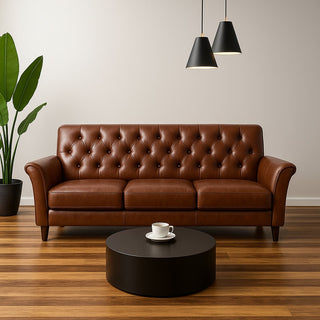If you’ve ever found yourself slumped into a saggy sofa, wondering when exactly it went from supportive to sad, you’re not alone. Your sofa is more than just a piece of furniture—it’s the centerpiece of your living room, your go-to nap spot, and, if we're being honest, a catch-all for snacks, pets, and life’s daily chaos. But how long should a quality sofa last before it starts showing its age?
The short answer? A high-quality sofa should last between 7 to 15 years—and in many cases, even longer with proper care. But that’s not the whole story. Let’s break it down and explore the factors that influence sofa longevity, how to recognise signs it’s time for a replacement, and tips to extend your sofa's life (and get the most out of your investment).
What Defines a “Quality” Sofa?

Before we dive into lifespan, let’s talk about quality. Because not all sofas are created equal.
A quality sofa typically includes:
-
Solid wood frame (preferably kiln-dried hardwood like oak, maple, or ash)
-
High-density foam or down cushions
-
Reinforced joints with dowels, screws, or corner blocks
-
Durable upholstery fabric like top-grain leather, performance linen, or tightly woven synthetics
It’s the combination of these materials and craftsmanship that separates a cheap couch from a long-lasting investment.
Average Lifespan of a Sofa by Quality Tier

Here's a quick overview of how long sofas tend to last, depending on their quality:
|
Sofa Type |
Expected Lifespan |
|
Budget sofa |
1-5 years |
|
Mid-range sofa |
5-10 years |
|
High-end sofa |
10-15+ years |
Remember, these are averages. A budget sofa that’s rarely used may last longer than a high-end couch in a busy household. But generally, better materials and construction = longer life.
7 Key Factors That Affect Sofa Longevity

1. Frame Construction
A sofa’s lifespan starts at its core: the frame. Quality sofas use kiln-dried hardwood, which resists warping and cracking over time. Cheaper couches use particleboard or plastic, which degrade faster under stress.
2. Cushion Quality
Ever sit down and feel like you’ve sunken into a black hole? That’s the foam breaking down. High-resiliency or high-density foam cushions can maintain their shape for up to a decade. Low-density foam may feel comfy at first, but it deteriorates fast.
3. Upholstery Material
Durability isn’t just skin-deep—but it starts there. Look for fabrics with high double rub counts (over 15,000 for residential use) or tough materials like top-grain leather, polyester blends, or microfiber.
4. Usage and Lifestyle
Do you have pets? Kids? Host movie nights with friends every weekend? All these factors put wear and tear on your sofa. The more it’s used, the faster it will wear out—even if it's a high-quality couch.
5. Maintenance and Cleaning
Regular vacuuming, spot cleaning, and cushion flipping can significantly extend your sofa’s life. Neglecting these steps accelerates fabric breakdown and fading.
6. Climate and Environment
Humidity, sunlight, and temperature fluctuations can age a sofa prematurely. Direct sunlight can cause fabrics to fade and leather to crack. Humid environments may lead to mold or mildew if not properly ventilated.
7. Weight Capacity
Every sofa has a recommended weight limit. Overloading it (hello, unexpected dog-pile during game night) can stress the frame and cushions, shortening its lifespan.
Signs It’s Time to Replace Your Sofa

Even the best-built sofa won’t last forever. Here are some telltale signs it might be time to say goodbye:
-
Sagging cushions that no longer bounce back
-
Wobbly or creaky frame
-
Rips, tears, or stains that can’t be removed or repaired
-
Uncomfortable seating (you’re constantly adjusting to find a sweet spot)
-
Outdated style that no longer fits your decor or lifestyle
Sometimes, the cost of repairs just isn’t worth it—especially if the sofa has sentimental value but not structural integrity.
Is It Worth Buying an Expensive Sofa?
This is a common question—and the answer depends on your needs, lifestyle, and long-term plans.
✅ YES, it’s worth it if:
-
You want a sofa that lasts 10–15+ years
-
You value craftsmanship and comfort
-
You’re furnishing a permanent or long-term home
❌ Maybe not if:
-
You’re furnishing a short-term rental or temporary space
-
You move frequently
-
You’re on a tight budget and don’t mind replacing furniture sooner
Think of a quality sofa as an investment, much like a mattress or a car. You spend a lot of time on it—it should support your body, reflect your style, and hold up over time.
Final Thoughts: Quality Over Quantity Always Wins

So, how long should a quality sofa last? Seven to fifteen years is a solid rule of thumb—but with smart buying decisions and regular care, your sofa could serve you well for even longer. And while the upfront cost of a well-made couch might be higher, the long-term savings (and comfort) often make it a better deal than buying cheap furniture every few years.
Remember: your sofa isn’t just a seat—it’s part of your home, your memories, and your lifestyle. Choose wisely, care for it well, and it will reward you with years of comfort and style.
Looking to invest in a quality sofa? Check out our Sofa Buying Guide or explore our hand-picked list of Top 10 Prestige Sofas to find the right fit for your space. Visit Megafurniture today and check out the most stylish sofa perfect for your Singaporean home.








